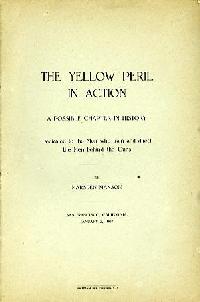Yellow peril in action
Five years after the Russo-Japanese War
By William Wetherall
First posted 18 July 2008
Last updated 4 June 2010

Marsden Manson Tiny print at the bottom of cover states reads "Britton & Rey, Printers, S. F.". The title and copyrights pages state "January 1907". The Preface (see below) is dated 22 December 1906. An elliptical world map, on a thinner stock of paper, folds out to nearly four leaves in width between pages 18-19. It is titled "MAP of the WORLD showing The three Great Oceans as Units and our Unfortified Military Stations" and appears to be an equal-area projection of the kind proposed by David Aitoff in 1889. The world shown on the map is centered on the Pacific Ocean, with "PEARL HARBOR, Honolulu" at its heart. A few localities, most of them in East and Southeast Asia and the Pacific, are labeled in small mixed case. The localities are sites of US military stations and incidents depicted in the story. |
Preface
Manson's The Yellow Peril in Action appeared two years after the Russo-Japanese War of 1904-1905 and at a time when California generally, and San Francisco especially, were hotbeds of concern among certain quarters about the possibility that the state and the city would be overrun by Orientals.
Though intended as social and political commentary, the pamphlet was written in the manner of a fictional story set in the future -- a future that is now in the past.
Manson prefaced the story with notes of both alarm and hope (page 3).
|
PREFACE The indifference with which our people and Congress regard the development of the commerce of the Pacific Ocean prompts the writer to point out some of the possibilities of a war and its effects upon that commerce and our industries. Incidentally other matters are brought in which have a bearing upon these and upon our Naval and Military Power. If this brochure shall serve to bring about a better understanding of our needs and a recognition of their importance, and shall tend to an abandonment of our policy of neglect, its purpose will be served.
|
Story
The story begins like this (page 5).
|
THE YELLOW PERIL IN ACTION A POSSIBLE CHAPTER OF [sic] HISTORY. Dedicated to the Men Who Train and Direct the Men Behind the Guns. (Supposed to be written in 1912.) In 1908 the friction between the United States and China became severe, and only by great forbearance and concessions had the actual braking out of hostilities been avoided. This near approach to war, although with a country having no navy comparable with that of the United States, induced the Congress meeting in March, 1909, to make quite liberal appropriations for fortifications at Manila, Pearl Harbor, Guam, Pago Pago and Kisga. On the basis of these appropriations contracts were let for materials, coal and supplies, and the War Department was ordered to go over the plans prepared many years ago for fortifications at these points and bring them up to the most modern requirements. It appeared that the unprepared conditions of these vital military and commercial points would be at last remedied. |
By the winter of 1909-1910, however, China "resumed the practice of 'boycotting' American goods and materials; and, American sailors and citizens were insulted and hooted in several Asiatic cities" (page 5). On the 13th of March 1910 the Chinese ambassador to the United States ordered Chinese members of the court to return to China, and two days they they embarked from New York on a German mail steamer. On the 17th the Chinese ambassador handed the US Secretary of State a declaration of war, demanded his passports, and on the 19th he sailed.
While China had no navy, it had an army (page 6).
|
The country was thunderstruck, China had no navy of moment, but her army, under Japanese example and training, had been put in a high state of efficiency, and her two ordinance works had been turning out high class arms and guns for several years. All her naval stations and commercial cities had been fortified in superb style and large stores and munitions of war were said to be on hand. The United States calmly and confidently began to prepare for war with an Asiatic foe. The general plan had been laid out to simply and effectively blockade Chinese ports and attack her commerce until she came to reason. . . . |
Under a 1908 treaty, "Great Britain . . . was expected to close Hongkong and Wei-Hai-Wei to Chinese vessels, both of war and commerce" . . . and she did so . . . But being in no way involved, her attitude was purely that of a friendly and sympathetic neutral" (page 6).
Things do not go well for the United States, which loses the conflict when US ports are blockaded by an Allied Asiatic fleet and infrastructure throughout the country is sabotaged. Many Chinese and Japanese in America are killed or injured in race riots.
Faced with huge war indemnities and reconstruction costs, Congress amends the Constitution, "absolutely prohibiting foreign immigration from all countries for ten (10) years; and FOREVER DENYING TO ANY PERSON THE RIGHT OF FRANCHISE UNLESS BORN AND EDUCATED ON AMERICAN SOIL AND BENEATH THE FLAG" (pages 24-25, bold emphasis and UPPER CASE in original).
"We have lost, it is true, all control of the commerce of the Pacific Ocean, and may never regain it, but we have gained control of that of our own country. We have learned that there shall be monopoly in transportation is the prime, essential law of prosperity" (page 28, bold emphasis in original).